FT-847 Modifications:
Separate receive connectors for 432 and 144MHz:
In many instances using a separate receive antenna connection is an advantage, e.g. high power and pre-amp usage, squezing every last dB of NF out of the system, or just plain saving on external relays.
I have installed separate SMA antenna receive connectors as described below:
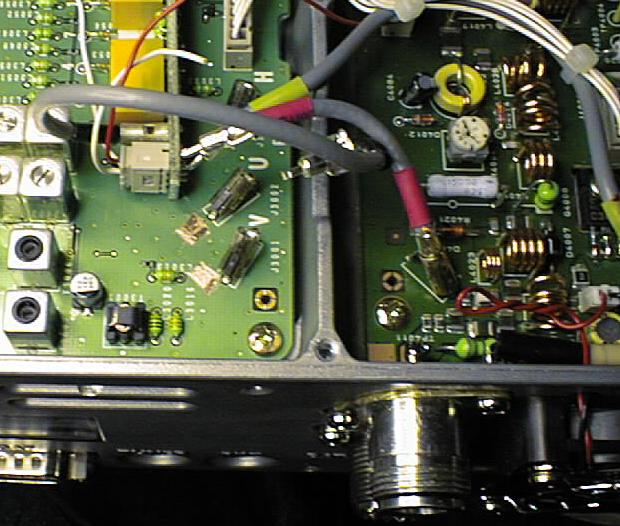
Here you see coaxial connections to the receive circuit (marked V and U), with the cables unplugged, and a small area in front scraped clean for soldering. Also visible is a sligth enlargeing of the rear air grille to receive one of the SMA connectors. Note also that the 144 antenna connector has been replaced with an N-connector - something Yaesu should have done from the factory!

Now the 144 receive connector has been mounted and soldered in place.
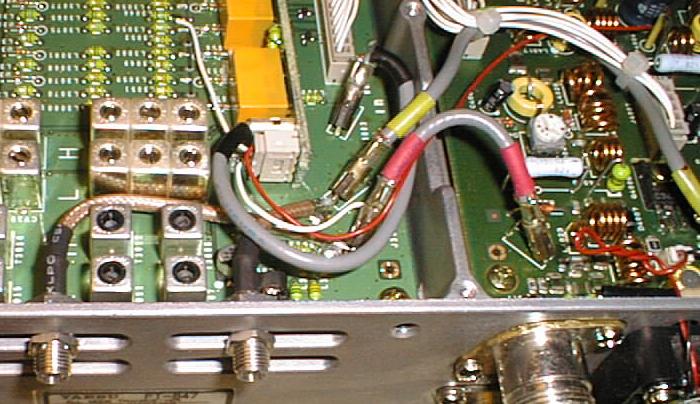
and the 432 as well. The original connection from the Tx/Rx switching circuit has been restored, and everything works as before, with the exception that you now have the option of using a separate receive connection, with a gain of almost 1dB noise figure! Finish off by securing the SMA connectors with judicial usage of Lock-Tite or Epoxy.
On/Off Switch:
Like most other FT-847
owners, I've gone through On/Off switches like a work horse through
oats, I'm now on my 4th (june 2010) in 12 years of ownership! Two of
them were mechanical failures and the other two burnt contacts. The
switch itself is a little cheap plastic thing (available from Farnell
as part. No. 1123861 (now replaced by part No. 1435767) but getting to it, is a bitch. I've put the
second (unused) contact set in parallel with the original, and now also
placed a 10nF capacitor over the contacts, to hopefully remove some of
the sparking that must take place.
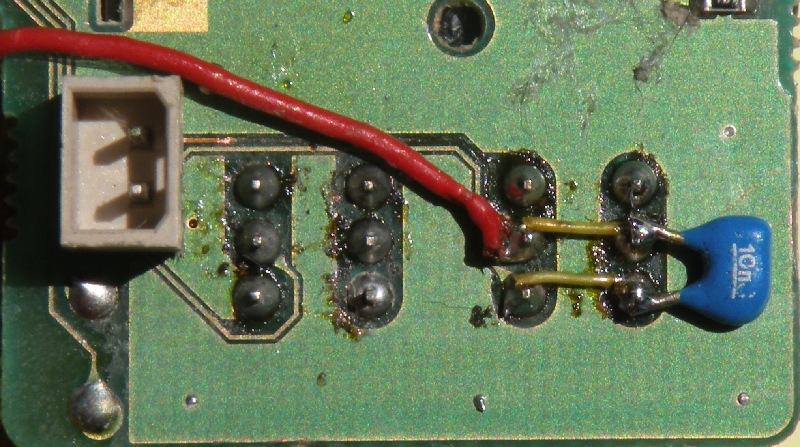
The
red wire is a replacement/repair for the trace that burned after a
flight to Kangerlussuaq (OX) in 2000, because a small piece of
aluminium that was glued to the chassic as a retainer for the PCB was
shaken loose and happened to land on the switch as a short.
Other Mods performed on my
FT-847:
I have replaced the headphone resistors with 10K ohm to gain equal AF level between the speaker and my head-set.
A 220 ohm/1W resistor has been inserted in the supply to the rear fan to reduce speed and noise.
I have now disconnected the rear fan completely, to no ill effect, although I would think twice if living in a tropical climate - Caveat emptor, let the buyer beware! This is now superseeded by my "Temperature controlled Fan-Speed" mod - see link below!
68K ohm has been inserted before the audio chip to improve the AF level control.
As mentioned above, I have also replaced the PL sockets for 144 and 50MHz with an N-socket.
While replacing a broken On/Off switch (For the third time in 6 years! (Shame on Yaesu)), I created yet another useful (for me at least) mod: Often, while contesting or DX'ing with headphones on, I have guests in the schack who want to listen in, instead of fooling around with external splitters etc. I just soldered a 47Ohm resistor over the headphone switch so that instead of muting the speaker completely, it now just reduces output.
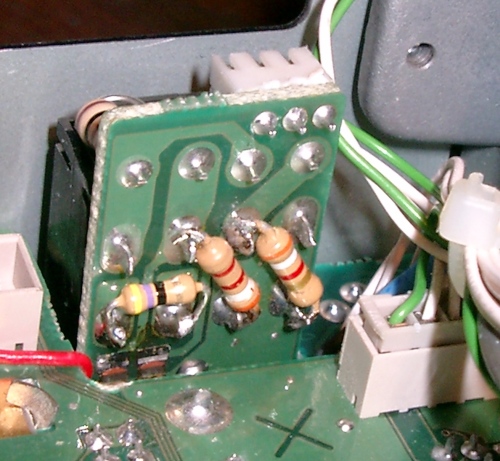
I have recently changed the IF-filters in the radio to the following set-up: SSB-Rx: Inrad #702, 2.1KHz Crystal filter ( http://www.qth.com/inrad/ ); SSB-Tx Collins 2.6KHz Mechanical filter, and CW: Collins 500Hz Mechanical filter.
On SSB Rx the improvement is incredible, the Inrad filter completely changes the radio's QRM-tolerance in a crowded HF band or during a 2m contest, of cause it cannot do anything about passband disturbances, but any clean station, even if only 5-10KHz away, is completely gone from the Rx, which was definitely not the case when I used the Collins filter in the Rx, and I have some very strong contest stations close by (Like SK7MW, OZ1IEP and others). This Collins filter is now doing good service in the Tx side, with reception reports indicating much nicer modulation than with the original Yaesu Ceramic filter.
Just recently I had quite a scare with my FT847: After 7 years of hard use, more than 1000 FSK441 and JTxx QSOs and 8000+ SSB QSOs all on 144MHz, it developed an intermittent Tx problem: No output, but everything else normal (I operate split Tx/Rx as per my homepage). Long hours of fault finding and experimental replacement of components (The PA transistor checked out OK), failed to clear the problem. I then discovered a faint cracking of the surface of D4007, one of the PIN-diodes of the antenna TX/RX change circuit, and a mechanical prod of the diode provoked the fault at will.
This is what I found after pulling the PA PCB:
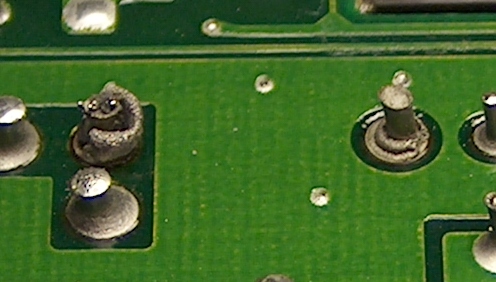
As you can see all the other solderings are OK, while the two leads of D4007 are completely detached. It turned out that the solder layer on the Iron component leads had evaporated completely, defeating all attempts to resolder it. A new diode was soldered in - this time using 5% Silver solder, and all is now well.
After more than 12 years of service, the "button-cell" battery (CR2016) finally gave up it's ghost - quite impressive in fact. Since I had a stock CR2016 on hand and didn't feel like paying several times the normal price for a Yaesu spare part (if at all available), I fashioned the mounting tabs from a strip of Cu foil, and soldered them directly to the battery before soldering in place.
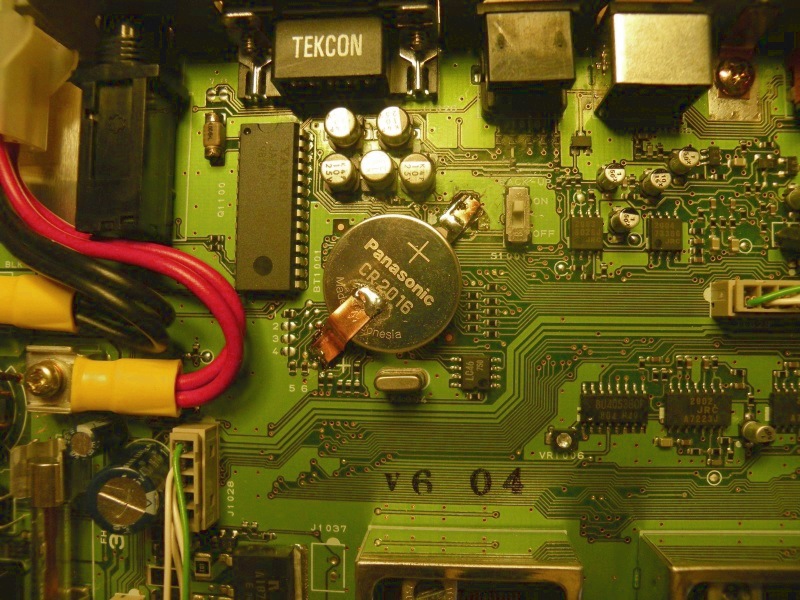
Apparently the soldering directly on the cell does nothing to prolong it's life! The new cell just gave up its ghost. Luckily I had located a suitable cell-holder (for the higher capacity CR2430 cell) since last time, so now it was time to get it in there:
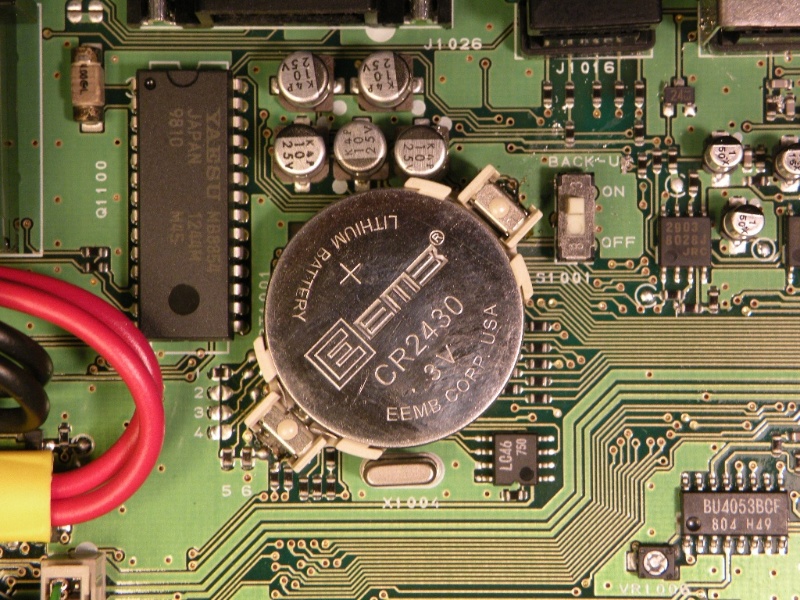
I have also, finally, done something about the annoyingly short leads to the built-in speaker, the are now long enough to completely move the shield off the radio before disconnecting the speaker!
For additional mods and tips, please have a look at the FT-847 FAQ, created by W1EMT, Jay - excellent! and, of cause, more of my own mods:
Temperature controlled fan-speed
"Oven" stabilized Reference Frequency Crystal!
AGC-On/Off switch Mod for the
FT-847
![]() Roofing Filter Mod for the FT-847 - Caveat: Not for the faint hearted!
Roofing Filter Mod for the FT-847 - Caveat: Not for the faint hearted! ![]()